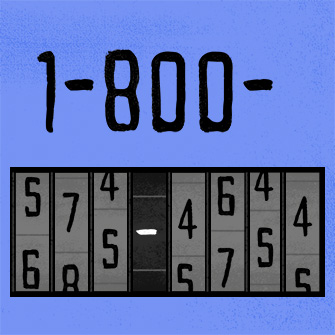In the age of cell phones and messaging apps, do Vanity Numbers — that is, custom 1-800 numbers and local numbers that spell out memorable words — actually make any sort of difference?
We wanted to find out for ourselves if 1-800 (toll-free) and custom numbers had any impact on people’s memories and behaviors, so we surveyed over 1,400 NumberBarn customers and asked them to be honest about their perceptions of personalized numbers (and we categorized them by their age, for good measure).
Key Findings:
- Nearly 85% of respondents said they were more likely to remember a Vanity Number after seeing or hearing it in an ad.
- Respondents were 35.59% more likely to patronize a business with a Vanity Number, versus a business without one.
- 21% of people have attempted to text a Vanity Number, with ‘Generation Z’ being the most likely to attempt to text a Vanity Number.
- Gen Z is the generation you are most likely to earn business from due to a Vanity Number (28.57%).
How We Define our Terms
We don’t want anyone to misinterpret the results because of varying definitions, so before we get to the results, it’s important we explain how we defined a few terms.
What is a Vanity Number?
Our survey defined “Vanity Number” as:
“…a number where the digits spell out a word or phrase for ease of memorization and recall. Popular Vanity Numbers that you’ve likely heard of include 1-800-FLOWERS and 1-800-CONTACTS. (For) this definition, we also include easy-to-remember telephone numbers with repeating digits and patterns, like 279-222-2222 or (628) 444-4444.”
What is each generation’s age range?
- Gen Z: After 1997
- Millennials: 1981-1996
- Gen X: 1965-1980
- Baby Boomers: Before 1965
Note: Yes, we’re aware that defining Baby Boomers as being born “before 1965” means it’s possible that older generations may be a part of those results. However, we do not believe this classification made a significant impact on the results. According to the Statista Research Department, the “Silent Generation” and the “Greatest Generation” make up only 7% of the entire population in the United States, and their exclusion are not statistically likely to have impacted our survey’s sample.
Are People More Likely To Remember Vanity Numbers?
Why is remembering a Vanity Number so important? Two words: Brand awareness.
We asked our 1,450 survey participants to rate whether they were “More likely to remember a Vanity Number (versus) a non-Vanity Number after seeing or hearing it in an advertisement”. Here are the results:
A strong majority of people reported they were “More likely” to remember a Vanity Number versus a non-Vanity Number. In fact, a whopping 84.97% of those surveyed said Vanity Numbers had an overall strong impact on them!
And why is remembering a Vanity Number most important? Two words, again: Brand awareness.
Remembering Vanity Numbers, by Age
Millennials and Gen Z reported the highest impact of Vanity Numbers on their memories, (91.44% and 90.48%, respectively), with Gen X (88.19%), and Baby Boomers (80.38%) also reporting a very significant impact.
What’s significant about this finding is that it’s the opposite of what you would expect to hear from younger people.
Younger generations anecdotally prefer to communicate via digital channels with increasing fervor, yet Vanity Numbers seem to be one of the few methods of advertising which stand a chance at attracting the attention of younger audiences.
But this begs the question: Will remembering a clever number be enough to make someone pick up the phone and call you or your business?
The Next Step: Actually Calling A Vanity Number
Here is what our 1,450 survey participants said regarding whether they were “more likely to call a (Vanity Number) compared to a non-Vanity Number after reading or hearing about it in an advertisement”:
Given the low-margin correlations between general advertisements and human behavior, you’d expect to see very little motivation to pick up the phone, yet the results tell us otherwise.
About 35% of respondents reported they’d be more likely to call a Vanity Number versus a non-Vanity Number. Another 37.38% reported a neutral stance. That’s a remarkably high percentage in the advertisement world!
If we’re being honest, these results came as a surprise to us. We predicted a lower probability of “calling a Vanity Number” as compared to “remembering one,” of course. But we expected reported “motivation to call” to be much closer to a single-digit result.
That could mean having a Vanity Number might give you an edge in converting ~35% of people who see your number compared to your competition’s regular phone number.
An interesting note on ‘Neutral’ stances
The most common trait across all generations is that they held a majority neutral stance on whether they’d be more likely to call a Vanity Number. But where the data gets interesting is when you look more closely at Gen Z and Baby Boomers.
Generation Z reported being the overall most likely to call a Vanity Number (47.62% across all positive answers). But they’re also the only generation that reported more people who “Strongly Agree” (28.57%), compared to simply “Agree” 19.05%).
On the other end of the spectrum, Baby Boomers held a strong stance in the opposite direction. They’re the only generation that had an ever-so-slightly higher percentage of people that said they “Disagree” (31.63%) they’d be more likely to call a Vanity Number, compared to the Baby Boomers that said they “Agree” (30.75%).
Closing the Sale: Choosing a Business Because of a Vanity Number
Now it’s time to close the deal. How likely is it that a customer will choose your business based solely on the fact that you have a Vanity Number?
Here’s what our 1,450 survey respondents reported regarding whether they were “More likely to choose to do business with a company that has a Vanity Number” compared to a business without one:
Generally, the further down a sales funnel you go, the fewer people you’re likely to convert. Yet when measuring the impact of Vanity Numbers, roughly 18% of respondents reported willingness to do business with a company that has one, versus a company that doesn’t.
That’s a big deal.
Sure, there are many contributing factors involved in generating and closing sales. But if your business relies on phone call conversions, a Vanity Number could significantly expand your visibility and allow new and existing customers to reach you faster!
Breaking Down Engagement With Vanity Numbers, by Age
Of the 18% of respondents who were the most receptive to Vanity Numbers, which generation was the most impacted by this kind of marketing?
If you’ve read this far, then you probably can guess: it’s Generation Z!
28.57% of Gen Z respondents said they were more likely to choose a business that uses a Vanity Number. That’s almost 7% greater than the next most likely generation, Millennials (21.39%). Gen Z is also the only generation that had a higher percentage of people who said they “Strongly Agree” (19.05%) versus “Agree” (9.52%).
Of those that were marked as engagers, Baby Boomers, once again, were the least likely to be influenced by a business’ Vanity Number (14.64%); Baby Boomers were the generation reporting the greatest overall “Disagree” percentage (41.58%).
Our findings are generally consistent with overall research on advertisement. Criteo conducted their own survey on consumer habits and online ads, which when broken down by generation, found that younger generations “feel the most positive about online ads and are most likely to take action after seeing an ad.”
But what about Generation X?
Don’t worry Gen X, we didn’t forget about you!
While Gen X ranked third in their likelihood to choose a business due to Vanity Number usage (20.93%), Gen X was the least likely to say they would choose a business based on Vanity Number usage.
You read that right. They were the only generation below 34.88% of overall dissenters. And with an overall low percentage of people who either agreed or disagreed, that naturally means they featured the highest percentage of people who said they were “Neutral” (44.19%) toward Vanity Numbers.
What does this mean?
That means they’re a toss-up. You might have a 21% advantage with a Vanity Number on Gen X, but you might need to add more substance to your marketing if your core demographic is between the ages of 44-59.
What About Texting? Offering SMS on a Vanity Number
You may just be missing out on potential customers if you don’t offer SMS with your Vanity Number. Here is what 1,450 survey participants said regarding if they “Have attempted to send a text/SMS message to a Vanity Number at least once in [their] life”:
This graph appears different from all the other topics we discussed, but the generational trends remain very predictable. Texting a business telephone number isn’t common practice, unless the business explicitly markets it.
But that doesn’t mean customers aren’t attempting to get a hold of you over text!
According to our survey, 21.24% of people actually have attempted to text a Vanity Number in their lives, while only 61.52% of people haven’t. Sure, a majority of people don’t text Vanity and Toll-free Numbers, but for the minority that do, it’s a pretty significant minority.
Again, Generation Z featured the highest percentage of people who text (38.1%), and Baby Boomers were the lowest (16.4%). Those results make sense!
Meanwhile, Millennials were the second-most likely to text a Vanity Number (27.27%), followed by Generation X (24.51%). If you don’t offer SMS messaging, you’re missing out on a sizable percentage of customers.
Vanity Numbers: USA Versus Canada
We’ve covered each generation and their stance on Vanity Numbers, but what about countries?
(While NumberBarn is expanding our global phone number availability, for the purpose of this study we are only focusing on the United States and Canada.)
Here is what our 1,450 survey participants had to say about Vanity Numbers, broken down by U.S.- and Canada-based results.
When switching between the data from the United States and Canada, there isn’t much of a difference. Only two instances occur with more than a three-percent difference in their responses, and even then, the difference never rose beyond a 5% disparity.
Who’s more likely to call and recall Vanity Numbers?
The short answer: there was virtually no difference.
Canadians were 1.24% more likely to say they remember a Vanity Number, at 86.11%, compared to 84.87% of Americans. Although when comparing only the results of those that strongly agreed, Americans held a slight edge (44.86%) over Canadians (43.52%).
Canadians were also barely more likely to call a Vanity Number over a non-Vanity Number (36.11%) versus Americans (35.54%).
Therefore, we can discern no cultural difference in the way Vanity Numbers are perceived between Canadian and American populations. However, this data does reinforce the importance of a toll-free number if you operate between the two countries, since there is no decline in Vanity Number usage between the two.
(Note: Consider a toll-free number to avoid long-distance charges for your callers, if your user base spans both the U.S. and Canada.)
Vanity Numbers Summed Up
With multiple ways to interpret this data, no matter how you look at it, Vanity Numbers serve to only help your business and boost your brand recognition.
- You may get more calls by putting your Vanity Number in front of younger generations. Or at minimum, you should consider your targeting techniques if your demographic happens to include people younger than Millennials and into the Gen Z generation.
- With a vanity number we can assume more eyes on your business phone number. If ramping up your call volume with a Vanity Number, consider strengthening your customer service team to handle potentially higher incoming calls.
- And finally, if you operate in both the United States and Canada, you probably should remain consistent between both countries as far as phone coverage is concerned; both countries were similarly engaged with Vanity Numbers.
Overall, having a well thought-out strategy will help you tremendously when owning a Vanity Number. If you need a quick and easy way to buy a Vanity Number of your own, browse through the NumberBarn marketplace to find the Vanity Number that’s perfect for you.
Illustrations by Daniel Fishel
Press Inquiries: For press inquiries, contact press@numberbarn.com
“This post has been updated December 2024. Original data comes from survey collection conducted between 2021-22.


